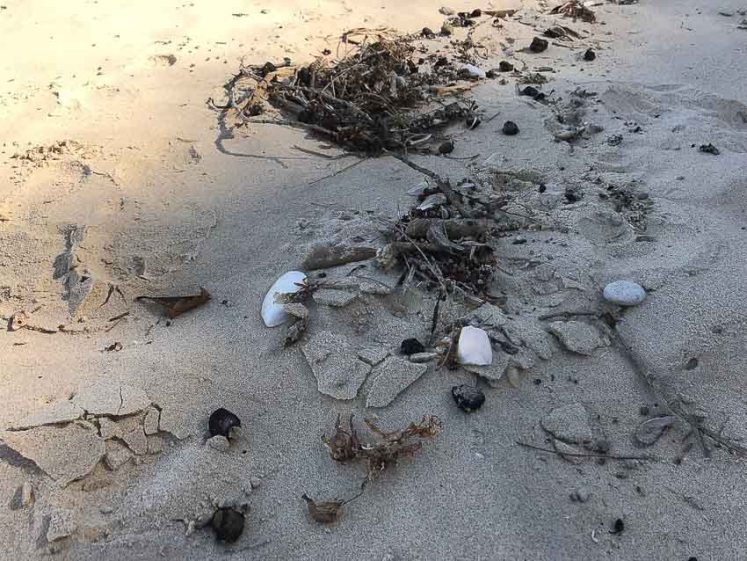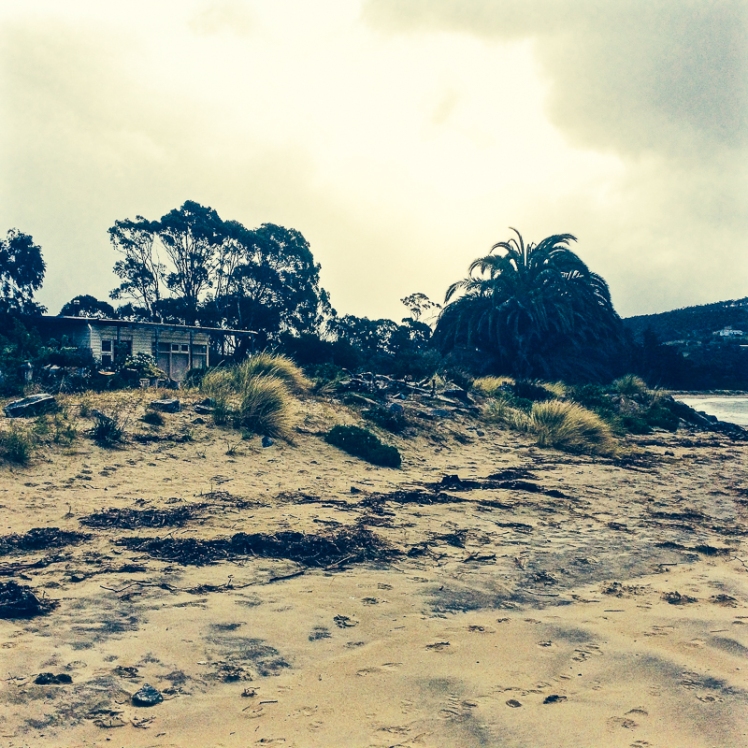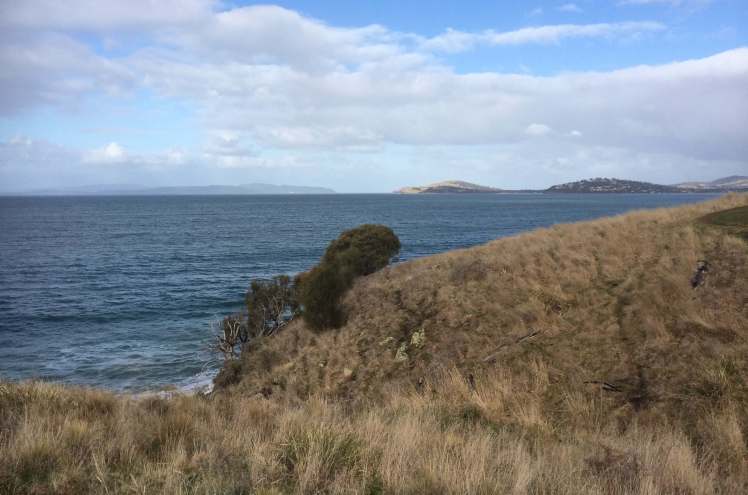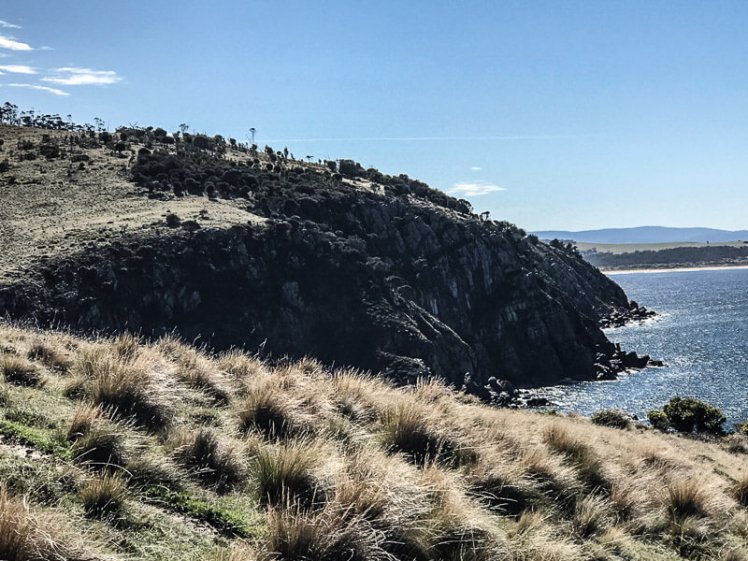A Physical Oxymoron: the Cuttlefish

In the lightest of my summer clothes I explore the winter rock pools beneath the two headlands that hold the cuttlefish beach tight. A fine trail of their shells lie in a tangle with little pumice stones, mangrove pods, seaweed and the occasional bright piece of tiny plastic that together have invariably traced the sea’s overnight reach up the beach on these southern winter and spring days.

Out in the bay whales may breach and the dolphins surf, but my curiosity is usually focussed on the tiny and the ordinary, although nothing – absolutely nothing– is ordinary about a beach when you start to look at it closely.
This beach is in northern NSW. It’s a short stroll from the long beach that fronts this tiny seaside community, but few people find their way around here, to where the cuttlefish wash up in all their diversity – the large and the small, the bitten and the untouched, the wide and the skinny. It’s not uncommon to find them on Tasmanian beaches too. In fact, they are sometimes the same species, just a bit more tolerant of those cooler waters.
Why so many are washing up on this beach I do not know. Perhaps, hanging around in the same vicinity they are hounded down by predators on the prowl. Perhaps they drift here on the current from exotic vicinities far away. Most likely it’s to do with mating and the high price that extols and most likely they are locals.

I’ve picked up huge pieces of cuttlebone, quite weighty, broken and scoured by a predator’s teeth. I’ve picked up the tiny, perfectly formed shells of newborns (unless there is a teeny tiny species out there) and longer shells, oval, with a pink blush and a tiny cusp. I’ve picked up the ones shaped like a plump leaf, with thin black lines sometimes etched on the anterior side.
I’ve picked all these up thinking they were the same but in sorting them I discovered a lot about my ignorance and a lot about their differences. I seem to have collected four distinct species, possibly more.
Cuttlefish Travel Across Time and Language

These exotic cephalapods are so well adapted that their trajectory extends forwards from the Cretaceaous period ‘which lasted approximately 79 million years, from the minor extinction event that closed the Jurassic Period about 145.5million years ago to the Cretaceous-Paleogene (K-Pg) extinction event dated at 65.5 million years ago,’ according to LiveScience. That’s pretty damn amazing. Humans are untested newcomers in comparison, given we’ve been around in this modern format only during the last 300,000 years (Wikipedia).
Cuttlefish grace the oceans in temperate and tropical locations worldwide, but curiously, they’re not in the Americas and the author of their Wikipedia entry suggests that one theory is that Gondwana had broken up by then and the North Atlantic had become too cold and deep for them to cross. I wonder about the cold bit, given that they’re comfortable in Tasmanian waters.
On the whole they seek out shallow water and are particularly partial to reefs, estuaries and seagrass meadows along the coast although amongst the many different species of cuttlefish, some do like their water deep.
The Greeks and Romans, keen on harvesting cuttlefish not only for their flesh but for their ink called the mollusc sepia.
‘Cuttle’ comes from the Old English name for the species, cudele, which may be connected to the Old Norse word koddi (cushion) as well as Middle Low German’s Kudel (Wikipedia).
Cuttlefish Magic: Embodying the bizarre

Cuttlefish are believed to prefer midnight feasts of shrimp and tiny fish to breakfasts and lunches but some species are out and about during daylight hours. They use two of their ten suckered tentacles with consummate skill, whipping these flexible ‘chopsticks’ out swiftly to pluck unwary fish and crustaceans into their beaky little mouths. It takes significant brain power to manage limbs, tentacles, defence mechanisms and their various mobility features. Its cousin, the octopus, uses nine brains to perform its daily rituals but a cuttlefish has one of the largest brain to body size ratios in the animal world and is known to be a fast learner.
I love the way they hold their tentacles in front of their faces when they swim. It makes them look like they have a long grooved snout. Perhaps this intimidates others while streamlining their motion, but that’s just an uneducated guess.
I’m sorry to make you think twice about that cuttlefish on your predatorial menu but they are unutterably beautiful and if you look them up on Youtube (see links below), you can’t help but feel somewhat mesmerised by the way they sashay about in a frilly sort of way. Think flamenco and think belly dancing for the way they ripple the soft fins along the sides of their body comporting themselves in a languorous or seductive manner.
Yet, no sooner have you thought this than you’re thinking zebras, toads and chameleons because although they are often striped they can change colour, skin texture and shape swiftly, blending into the background by making like they’re seaweed or a rock, or alternatively showing off with a bit of fluorescence or splashes of dazzling disco skin colour (Australian Museum). They use their skin to ‘speak’ or express their feelings, flashing messages via dynamic spots and colourful pulses. For instance, they might colour up one side of their body to bedazzle a potential partner while shading the other side to emphasise a ‘piss off’ to a contender (The Animal Communication Project).
They are physical oxymorons, edible but venomous. Their muscles contain a toxic compound with some suggestion that they are as lethal as blue-ringed octopus. (MarineBio, 2016) Their skin is a canvas and they wield colour like an artist – and yet they are colour blind.
That shell encountered on the beach is actually a phenomenal piece of engineering. We see shell and wonder about gifting it to our budgies or those artistically inclined might sculpt it like a piece of scrimshaw, and those who are frugal might pound it to add to a homemade toothpaste, or to a polish, but a cuttlefish uses this aragonite shell in lieu of a backbone, a shell that does double duty as a nifty buoyancy device because by pumping liquid in and out of the lattice of the minuscule chambers that make up the shell they are able to adjust the internal gas to liquid ratio, and this allows them to migrate up and down the water column, making like an elevator.
There’s a muscular mantle attached to that cuttlebone. It forms a sort of cavity, open at the front and it is also a mobility device. When the mantle muscle contracts, a whoosh of water whips through this siphon, strong enough to propel this magician of the seas at rapid speed. This is the same way it conjures up a cloak of black ink to confuse the enemy – the original “India Ink’ we used in fountain pens once upon a time and the sepia of the Greeks and Romans.
There are many other interesting things about a cuttlefish’s internal geography (for instance, they have three hearts) but for me those eyes have it. There is something soulful about those deep dark, W shaped ancient eyes in a body full of frills and artifice, those colour blind eyes of a master of colour and disguise. Those eyes have an underwater knowingness, but their lifespan is a mere two years. They come together in a big festive crowd to spawn and then, completely spent, they die. A popular place to see Giant Cuttlefish migrate for this molluscan orgy is off Whyalla in the Spencer Gulf, South Australia. (Here is some fantastic youtube footage by Pink Tank Scuba (2015).)
Maternal Cuttlefish Behaviour

The mother may not be around to care for her offspring but she lavishes care on her eggs, carefully hiding and tending them on the under side of rocks, jetties and other shady overhangs. There are sometimes about 30 to 50 eggs in a cluster and they’re not all from the same mother.
Once I read about this I immediately went looking. It was a fine October day and I did actually find eggs in a cluster on the under side of a rock, hanging there like glistening white raindrops, but I couldn’t identify them with 100% certainty and the ease of this find seemed too good to be true given that there’s a lot of diversity in those rock pool worlds.
Cuttlefish as Predator and Prey
Quite a lot of the cuttlefish I’ve collected have smallish teeth marks scouring the shell or making frills along the edges. The literature suggests it’s usually dolphins or sea lions but they’re also preyed on by sharks and larger cuttlefish. Perusing the research it appears cuttlefish numbers have dropped dramatically but are now rising. Some scientists think that overfishing and climate change might, at least for now, be working in their favour.
The Cuttlefish Who’s Who
Cuttlefish are molluscs and belong to the gastropod family. The giant cuttlefish (Sepia apama) is easy to identify by its size. Wild seas over the last few days have brought by the wind sailors, portuguese man ‘o wars in their droves, violet snails and cuttlefish onto the beach in droves. I found two almost perfect giant cuttlefish shells that had been floating around in the oceans for a pretty long time. You could tell; they were encrusted with goose barnacles, most small, but one in particular was large and curious, coming out of its shell to question where the water had disappeared to, I assume.
Next time you find a cuttlefish and you want to figure out whether it’s the Knifebone cuttlefish (Sepia cultrate), the slender Braggs cuttlefish (Sepia Braggi Verco), the oval yellow ridged Smith’s cuttlefish (Sepia smithi Hoyle), one of the various species, one out of place or one yet to be discovered, head over to this guide for the lowdown or visit the cephalopod section on the Australian Museum’s molluscs page. It’s pretty obvious when you’ve found a Giant cuttlefish Cuttlefish/Giant Cuttle – Sepia apama, as it’s all of 80 cm- 1m when fully grown.: Although they haven’t been studied all that much, they are apparently quite common and are fished – and so yep, we better add ourselves to that list of predators.
About my Research

I started off curious about the different shapes of cuttlefish shell I was finding on the beach but as well as finding out about these cephalopods, these molluscs, these gastropods, losing time to youtube videos about them, I also wandered down related trails and found out some interesting info about people who have studied them, like the interesting Mr Bragg, and stumbled upon some engrossing blogs, like Susan Scott’s. She’s a sailor and marine biologist and I quickly downloaded her book. Here’s her post on cuttlefish.
But I’m still not sure about those eggs and I’m not entirely confident I know the species I’ve found, so if you can help me identify them please leave a comment :).
More sources:
Guide to cuttlefish species in Australia. Monceaux, D. 2015
Cuttlefish Camouflage: New York Times interview on Youtube with Dr Roger Hanlon of Woods Hole, MA
Giant Australian cuttlefish (Sepia apama) mating behaviours, 2012. Dr Roger Hanlon. Youtube.
Cuttlefish laying eggs. National Marine Aquarium, 2017. Youtube video.
Cuttlefish eggs. The Nature Box, 2017. Youtube video








































